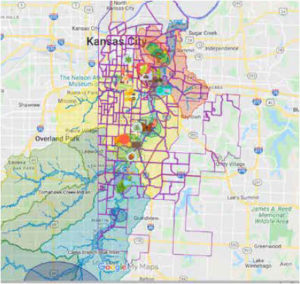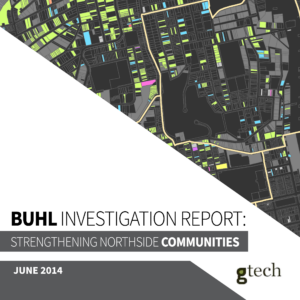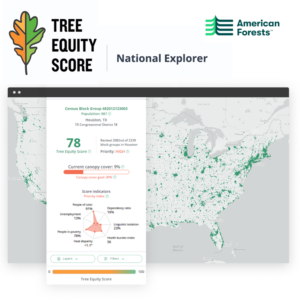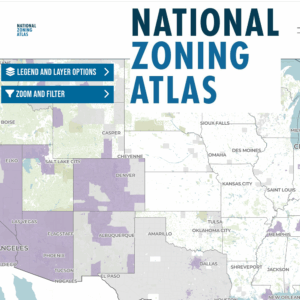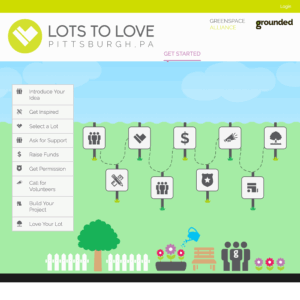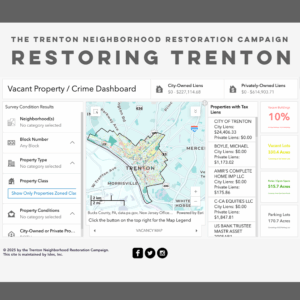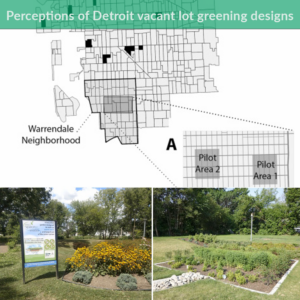Vacant Land Elements Examples
Vacant land stewardship requires four fundamental elements: knowing your community’s context, having clear goals and plans, committing to collaboration, and enacting facilitative policies. These four elements will look different in every community, but they are all critical components of implementing successful vacant land stewardship. To learn more about these elements and discover some next steps for your community's learning journey, explore the element examples below.
Element Type
Organization
Heartland Conservation Alliance
This mapping tool is designed to help prioritize the vacant lots that can have the most environmental and health benefits for urban communities. The tool provides parcel specific information and important contextual information like if it is in a flood…
Read More »Grounded PGH (Formerly GTECH)
The Northside Vacant Lot Assessment collected information on the condition of vacant lots in Pittsburgh’s 19 Northside neighborhoods. The assessment was conducted by resident volunteers and community organizations.
Read More »American Forests
The Tree Equity Score tool calculates a “tree equity score” for all 150,000 neighborhoods and 486 municipalities in urbanized areas across the continental United States.
Read More »Cornell University Legal Constructs Lab
The National Zoning Atlas enables users to visualize the prevalence and nature of regulatory constraints, particularly on housing. The Zoning Atlas is an important tool to help people understand what their local zoning codes say; compare codes across jurisdictions, illuminate regional and statewide trends, and strengthen national planning for housing production, transportation infrastructure, and climate response.
Read More »Grounded Strategies
Lots to Love is an online guide for community organizations and residents in the Pittsburgh region who are interested in transforming vacant lots into well-loved spaces. This website, created by the nonprofit Grounded Strategies, connects users to resources and ideas to support reuse of vacant lots, and provides information about organizations currently doing this work in the Pittsburgh region.
Read More »Trenton Neighborhood Restoration Campaign
In 2014, the Trenton Neighborhood Restoration Campaign (TNRC) organized the first truly comprehensive, parcel-level survey of all the vacant properties in Trenton — mapped, published, and updated on this interactive website. The TNRC also organized residents and local groups to draw attention to the problems caused by vacant and abandoned properties.
Read More »UConn College of Agriculture, Health and Natural Resources Doctoral Researcher Pan Zhang and Assistant Professor Sohyun Park
The Vacant Land Assessment System (VLAS) uses ArcGIS tools to create strategies for assessing and prioritizing vacant lots for their most suitable regeneration possibilities. The tool analyzes the geographical surroundings, potential repurposing strategies and property features to classify them and provide ideas for transforming the lots. The VLAS framework becomes a powerful strategy for future planning in a way that is collaborative across disciplines and stakeholders and assesses lots effectively.
Read More »Elevated Chicago
In Elevated Chicago’s report, a case study of two areas in Chicago near transit hubs discuss the impact of vacant lots as well as the potential they hold for the area.
Read More »University of Michigan, School for Environment and Sustainability
A study led by the University of Michigan and the University of Michigan-Dearborn aims to understand the connection between vacant lot maintenance, such as greenwater storm infrastructure (GSI), and subsequent mental health effects.
Read More »Groundwork USA
The New Orleans Green Infrastructure Map is an ArcGIS map, created in partnership with Groundwork USA, Groundwork New Orleans and several community partners, seeks to document the various greening initiatives across the city of New Orleans.
Read More »Heartland Conservation Alliance
This mapping tool is designed to help prioritize the vacant lots that can have the most environmental and health benefits for urban communities. The tool provides parcel specific information and important contextual information like if it is in a flood…
Read More »Grounded PGH (Formerly GTECH)
The Northside Vacant Lot Assessment collected information on the condition of vacant lots in Pittsburgh’s 19 Northside neighborhoods. The assessment was conducted by resident volunteers and community organizations.
Read More »American Forests
The Tree Equity Score tool calculates a “tree equity score” for all 150,000 neighborhoods and 486 municipalities in urbanized areas across the continental United States.
Read More »Cornell University Legal Constructs Lab
The National Zoning Atlas enables users to visualize the prevalence and nature of regulatory constraints, particularly on housing. The Zoning Atlas is an important tool to help people understand what their local zoning codes say; compare codes across jurisdictions, illuminate regional and statewide trends, and strengthen national planning for housing production, transportation infrastructure, and climate response.
Read More »Grounded Strategies
Lots to Love is an online guide for community organizations and residents in the Pittsburgh region who are interested in transforming vacant lots into well-loved spaces. This website, created by the nonprofit Grounded Strategies, connects users to resources and ideas to support reuse of vacant lots, and provides information about organizations currently doing this work in the Pittsburgh region.
Read More »Trenton Neighborhood Restoration Campaign
In 2014, the Trenton Neighborhood Restoration Campaign (TNRC) organized the first truly comprehensive, parcel-level survey of all the vacant properties in Trenton — mapped, published, and updated on this interactive website. The TNRC also organized residents and local groups to draw attention to the problems caused by vacant and abandoned properties.
Read More »UConn College of Agriculture, Health and Natural Resources Doctoral Researcher Pan Zhang and Assistant Professor Sohyun Park
The Vacant Land Assessment System (VLAS) uses ArcGIS tools to create strategies for assessing and prioritizing vacant lots for their most suitable regeneration possibilities. The tool analyzes the geographical surroundings, potential repurposing strategies and property features to classify them and provide ideas for transforming the lots. The VLAS framework becomes a powerful strategy for future planning in a way that is collaborative across disciplines and stakeholders and assesses lots effectively.
Read More »Elevated Chicago
In Elevated Chicago’s report, a case study of two areas in Chicago near transit hubs discuss the impact of vacant lots as well as the potential they hold for the area.
Read More »University of Michigan, School for Environment and Sustainability
A study led by the University of Michigan and the University of Michigan-Dearborn aims to understand the connection between vacant lot maintenance, such as greenwater storm infrastructure (GSI), and subsequent mental health effects.
Read More »Groundwork USA
The New Orleans Green Infrastructure Map is an ArcGIS map, created in partnership with Groundwork USA, Groundwork New Orleans and several community partners, seeks to document the various greening initiatives across the city of New Orleans.
Read More »